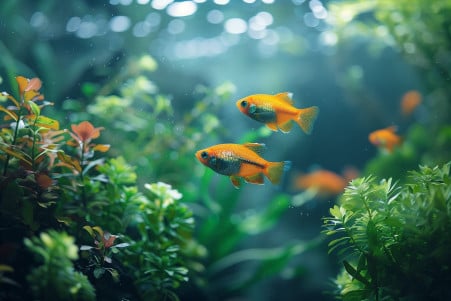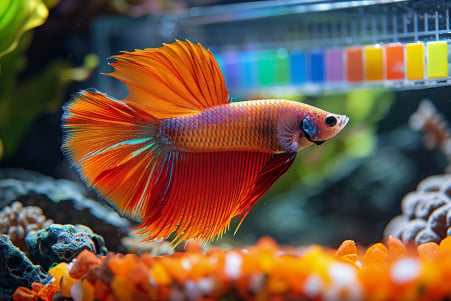How to Lower Ammonia Levels in Your Fish Tank? A Comprehensive Guide
9 April 2024 • Updated 9 April 2024

If you notice a strong smell of ammonia coming from your fish tank, you need to take action to lower the ammonia levels in the water. To lower ammonia levels in your fish tank, perform partial water changes of 25-50% every few days, vacuum the gravel to remove waste, make sure the tank is not overpopulated, and use ammonia-removing filter media or live plants.
In this article, we'll walk you through the best ways to do this according to scientific studies and experienced fish tank owners. By using proven chemical and biological techniques, you can lower ammonia levels and create a healthy environment for your fish.
How can you lower ammonia levels in a fish tank?
What Is the Nitrogen Cycle and How Do You Cycle a Fish Tank?
The nitrogen cycle is one of the most important biological processes in an aquarium, says The Beginner's Guide to the Nitrogen Cycle for Aquariums. It's the process by which toxic ammonia produced by fish waste is converted into nitrites and nitrates by bacteria. The nitrogen cycle is carried out by two groups of bacteria - Nitrosomonas, which convert ammonia to nitrites, and Nitrobacter, which convert nitrites to nitrates.
Before fish can be added to a new tank, these beneficial bacteria need to be established in a process called "cycling," which is described in How to Cycle a Fish Tank. This process involves adding an ammonia source to the tank and then waiting 4-8 weeks for the bacteria to grow and the nitrogen cycle to stabilize. During this time, it's important to test the water for ammonia, nitrite, and nitrate and do water changes if the levels of any of these chemicals get too high to prevent future fish from being harmed.
To speed up the cycling process, The Aquarium Nitrogen Cycle suggests keeping the tank at optimal conditions, including 80%+ oxygen saturation, a temperature of 80-82°F, and using supplements or gravel from an established tank. Once the tank is cycled, the bacteria will continue to break down fish waste, but the nitrates will still need to be removed through water changes, according to The Nitrogen Cycle in Aquariums. Cycling the tank before adding fish ensures that the biological filtration in the tank will be able to handle the ammonia produced by the fish.
Filtration Systems and Media That Work for Ammonia Removal
Good filtration is important for keeping ammonia levels in check in your tank, according to Fish Tank Filters: Which One Should You Get?. There are a number of filter media that can help with ammonia removal. Biological media like ceramic rings, bio-balls, and sponges offer a large surface area for the beneficial nitrifying bacteria to live on and convert ammonia into less harmful nitrites and nitrates.
Chemical media like ammonia-removing resins and zeolite can also absorb and remove ammonia from the water directly, according to the Ammonia Filter Pad product page. Mechanical filtration with filter floss and sponges will also capture solid waste particles that contain ammonia.
When choosing a filter, make sure that you're getting one that has the right capacity for the size of your tank and the number of fish in it, and that it uses a mix of mechanical, chemical, and biological media. As noted in the Ammonia and nitrite reducing filter media discussion, biological media like Seachem Matrix or Marine Pure can offer a good surface for bacteria to grow on without directly absorbing ammonia.
It's also important to make sure that you're keeping up with regular maintenance on your filtration system, including cleaning and replacing the media, in order to make sure that you're keeping ammonia levels low and your fish healthy.
Water Changes and Other Maintenance for Ammonia Control
Frequent water changes are a must for keeping ammonia levels in an aquarium under control, as noted in TREATING AMMONIA TOXICITY IN AN AQUARIUM OR FISH POND. Water changes of 25-50% every 1-3 days will help quickly dilute and remove any built-up ammonia. It's also important to vacuum the gravel during water changes to remove solid waste that can decay and add to the ammonia load.
In addition, How to lower ammonia levels naturally explains that it's important to keep a well-cycled and mature filter to help maintain ammonia levels over time. This will ensure that the beneficial nitrifying bacteria that convert ammonia into nitrites and nitrates have a place to live. It's also important to avoid overfeeding and overstocking the tank, as these can lead to more waste and higher ammonia levels.
It's also important to test the water regularly to keep an eye on ammonia levels, as well as other water parameters like nitrites, nitrates and pH. As suggested in TREATING AMMONIA TOXICITY IN AN AQUARIUM OR FISH POND, ammonia should be retested every 1-3 days during an ammonia crisis, and regular testing should continue for 2-6 weeks to make sure the levels stay where they should be. Changing up maintenance schedules based on the results of these tests can help ensure that the aquarium stays healthy and free of ammonia.
Natural and Eco-Friendly Ways to Lower Ammonia
One of the most natural and eco-friendly ways to lower ammonia in an aquarium is to use live plants. As explained in Do Plants Remove Ammonia from Aquarium Water?, aquatic plants can directly take up ammonia from the water and use it as a nutrient for their own growth. This means that ammonia is removed from the water before it can reach levels that are toxic to fish.
The Aquarium Aquascaping Forum lists hornwort, water wisteria, and java moss as some of the best plants for removing ammonia from the water. These plants don’t need to be planted in the substrate, and they can be floated or attached to decor, so they are easy to incorporate into any aquarium. In addition to consuming ammonia, the presence of live plants can also help support the growth of nitrifying bacteria that convert ammonia into nitrates.
In addition to live plants, other natural methods such as using zeolite or clay-based media can help absorb and remove ammonia from the water, as noted in How To Lower Ammonia In Your Aquarium Fast & Safely. By using these eco-friendly methods, as well as regular maintenance and water changes, you can help ensure that your aquarium is a healthy and balanced environment that naturally keeps ammonia in check.
Conclusion: How to Keep Your Aquarium Healthy and Ammonia-Free
It’s clear that keeping ammonia levels in check is important for the health and happiness of your fish. This article has covered everything from the basics of the nitrogen cycle and the importance of cycling new tanks to the ins and outs of filtration systems and media, water changes, and natural methods like live plants.
The bottom line is that you need to take a comprehensive approach that includes all of these methods. Regular water testing, filter maintenance, and monitoring and adjusting your fish’s diet and the number of fish in your tank are all important parts of keeping ammonia at safe levels. By focusing on maintaining a stable, ammonia-free environment, you can help your fish live long, healthy lives and enjoy the beauty of a thriving aquarium.
Keeping an aquarium is a big commitment, but the benefits of a healthy, low-ammonia tank are well worth it. With the right information and consistent effort, anyone can create and maintain an aquarium that provides a safe, healthy environment for their fish.


